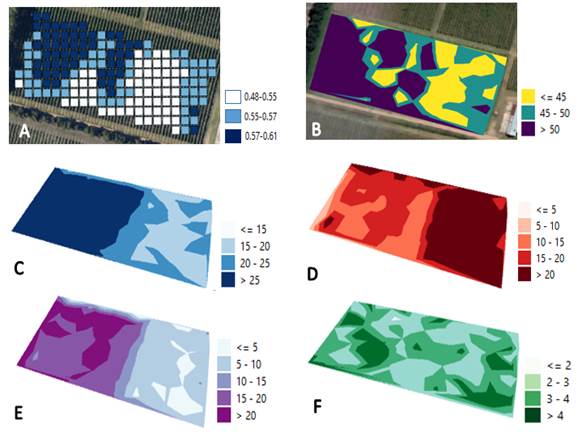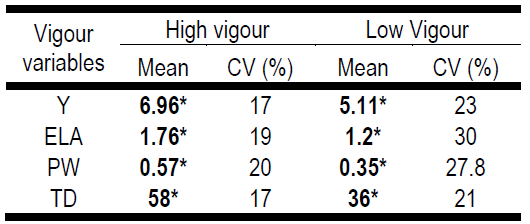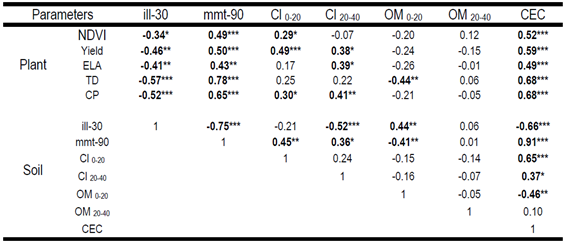1. Introduction
Uruguay's viticultural history began with the arrival of the first Spanish and Portuguese immigrants during the colonial period. Currently, production extends over approximately 7,000 ha and generates about 30,000 direct and indirect jobs. Tannat is the emblematic Uruguayan variety due to its good performance in the country’s soil and climatic conditions. The diversity of geological materials has generated very different soil types in Uruguay1. In the south, these soils have developed on sediments. They are moderately deep (50 to 100 cm), clayey, and have a B horizon of illuvial character2. The predominant soils are classified as fine, smectitic, thermic Verticargiudoll, with particular properties: high organic matter content and richness in expansive clays of type 2/13. The temperate climate of Uruguay, with around 1100 mm rain per year, allows grapevine cultivation with high yield objectives.
The soil physical properties (texture, structure, depth, colour, and temperature) and chemical properties (pH, electrical conductivity and nutrient availability) are determinant for plant functioning4)(5, determining grape vigour and quality5)(6. Thus, the soil variability can generate an heterogeneity of plant growth and functioning, as observed by vegetation imagery in some vineyards7. The non-uniformity of yield, berry composition and berry sanitary status can lead to technical, economic, and environmental issues8)(9)(10)(11. It is then important to identify the soil factor(s) playing a key role(s) in vine heterogeneity to propose corrective management levers. The presence of montmorillonite and illite is a typical signature of the soils of South Uruguay3, but the proportion of these two clay types is unknown and seems variable throughout the region. Variation at the field level seems to have escaped any investigation.
The objective of this short communication was to evaluate the relationship between the field heterogeneity of grapevine in terms of plant variables (vigour and yield) and the physical and chemical soil characteristics, including in particular the content of illite and montmorillonite. For such purpose, a vineyard displaying strong heterogeneity of plant vigour was used as a case study.
2. Materials and methods
2.1 Study site
The field of the study was a commercial vineyard of 1.1 ha planted in 1998 with Vitis vinifera L. cv. Tannat, grafted on SO4 rootstock. This vineyard is located in Canelones, Uruguay (34° 36 S, 56° 14 W), 56 km away from Montevideo. The vine spacing was 2.5×1.2 m (3333 vines ha-1). The vineyard was on a gradual slope of 1-2% (north/south). Vines were cultivated using a double guyot system and trained to a vertical shoot position. The vineyard was not irrigated. An intercrop occupied the inter-row and was regularly cut (mixture of Graminaceae spp. and Asteraceae spp.). The vineyard was characterized by high variability of yield and berry composition. Crop vigour was assessed at veraison by the Normalized Difference Vegetation Index (NDVI), calculated using aerial images, as described in Ferrer and others10. The vines were geo-referenced using a GPS (Thales Navigation Inc., San Dimas, CA, USA).
2.2 Soil determinations and characteristics
The chemical and physical properties of the soil were determined. For this purpose, soil samples were taken within the vineyard following a grid layout (10.8×12.5 m), obtaining 84 sampling points. The depths of sampling were 0-20 cm and 20-40 cm. During winter 2015, organic matter (OM), the percentage of sand (Sa), clay (Cl), and silt (Si) were determined for the two depths, while cation exchange capacity (CEC) was determined for the 0-20 cm samples.
To identify and quantify the different clay fractions (CT), a mixed soil sample was taken at a depth of 20-30 cm for each vigour zone (High Vigour: HV, and Low Vigour: LV). The clay fractions were analysed by X-ray diffractometry (XRD), as described by Beaux and others12 at the laboratory of the Department of Technological Development of CURE (http://www.cure.edu.uy/). The methodology for sample preparation and clay analysis was adapted from Carroll13.
To determine the montmorillonite and illite contents in the soil, we have admitted that kaolinite was negligible3, and we have considered that soil CEC is the sum of partial CEC (Eq. 1), and that the clay content is the sum of clay type contents (Eq. 2).
Considering 30 and 90 cmol+.kg-1 for CEC of illite and montmorillonite14, and 250 cmol+.kg-1 for OM15, the equation (Eq. 1) becomes:
The set of equations (Eq. 1 bis) and (Eq. 2) was solved for every point corresponding to a soil sample. The QGIS (Geographic Information System; 2021) program was used to draw maps of the trunk diameter, CEC, montmorillonite, illite and OM using TIN interpolation.
2.3 Plant growth and yield components
In winter 2020, trunk diameter (TD) was evaluated, following the same grid scheme used for soil analysis (n=84), by a digital caliper (Neiko 01407 ± 0.2 mm) at 10 cm above the grafting point following the methodology proposed by Santesteban and others16. For each plant, two measurements were taken, one transverse and one longitudinal to the row. The average of both measures was used as the average TD for that plant.
The influence of soil properties on plant response was addressed within two randomized blocks characterized by high vigour (HV) and low vigour (LV) with three replications for each of them. Each replication included 21 vines distributed in two rows (63 plants per treatment). The plant parameters were the following: Exposed leaf area (ELA, m2/vine) assessed at veraison by the method proposed by Carbonneau17, Yield (Y, kg/vine) measured at maturity, and Pruning weight (PW) measured during winter. Pearson's linear correlation between plant parameter and soil parameters, or between soil parameters were calculated. Soil parameters included the illite content, ill-30 (for illite at 30 cmol+ kg-1) and montmorillonite content, mmt-90 (for montmorillonite at 90 cmol+ kg-1) in the 0-20 cm layer, clay (Cl 0-20, Cl 20-40) and organic matter (OM 0-20, OM 20-40) in the two layers and CEC of the 0-20 cm layer.
3. Results
Three NDVI ranges were delimited within the vineyard, corresponding to high (NDVI 0.57 to 0.61)/medium (NDVI 0.55 to 0.57)/low (NDVI 0.55 to 0.48) (Fig. 1, A). The vineyard's west part reached NDVI corresponding to the high vigour class (HV), while the NDVI on east part corresponded to the low vigour class (LV). Those zones were corroborated by the range of trunk diameter values (Fig. 1, B). The variation of the trunk diameter at plot level was 20% (CV) with a mean value of 49 mm (range: 30 to 66 mm).
The mean CEC decreased from HV to LV zones (Fig. 1, C), ranging from 24-35 cmol+ kg-1 in the HV zone and 14-23 cmol+ kg-1 in the LV zone. The spatial variation of CEC was similar to the one of NDVI, with higher CEC in the HV zone and lower CEC in the LV zone.

Figure 1: Vigour and soil properties maps. Vigour by NDVI (A); vigour by trunk diameter (φ in mm, B); CEC map (cmol+ kg-1, C); illite content (%, D); montmorillonite (%, E); organic matter (%, F). Soil maps in a depth of 0 to 20 cm. n=84
On average the content of illite (Fig. 1, D) was 18.8% (range 4.6 to 28.8%), while montmorillonite (Fig. 1, E) was 14.4% (range 3.7 to 26.7%).
Organic matter was on average 2.9% at 0-20 cm depth. Some areas presented higher OM content (Fig. 1, F) than others. These areas did not follow the patterns of NDVI map.
Mineralogical analysis of the clays showed differences in the abundance of 2:1 clays. The HV zone had 79% montmorillonite and 20% illite. In contrast, the LV zone reached 34% of montmorillonite and 60% of illite. Both soil zones had a low content of the 1:1 clay type kaolinite (between 1% for the HV zone and 6% for the LV zone).
The high vigour (HV) zone was characterized by higher yield and vegetative growth compared to the LV zone (Table 1). The most significant heterogeneity (CV) was found in low vigour for the four variables studied. ELA and PW were the variables with the greatest dispersion in the plot. As well, for these variables, the CV is particularly higher in low vigour zone compared to high vigour. Trunk diameter was correlated with the following plant variables: NDVI (r2: 0.58; p-value: 0.05), ELA (r2: 0.60; p-value: 0.05); Y (r2: 0.69; p-value: 0.001) and PW (r2: 0.63; p-value: 0.05).
Table 1: Plant variables mean values and variability according to the vigour zone

Y: Yield (kg/vine); ELA: Exposed Leaf Area (m2/vine); PW: Pruning weight (kg/vine); TD: Trunk Diameter (mm). The * indicate significant differences according to the Fisher test (p-value < 0.05). n=63 (Y, ELA and PW) n=84 (TD).
Correlations between plant and soil variables, or between soil variables, were analysed. NDVI correlated negatively with illite content and positively with montmorillonite content. The illite and montmorillonite contents also correlated with the TD, ELA, cane production and Y (Table 2). The correlations were negative for illite and positive for montmorillonite, with higher level of significance for montmorillonite. All the plant parameters also correlated positively with CEC. However, no correlation of plant parameters with organic matter was observed (except a negative one for TD).
The soil parameters showed little correlation except for the clay types. The organic matter in 0-20 cm correlated positively with illite but negatively with montmorillonite. This is concordant with the negative correlation of CEC and organic matter in 0-20 cm because montmorillonite has more weight in soil CEC than organic matter. Illite content (in 0-20 cm) correlated negatively with the clay content in 20-40 cm, while the opposite was true for montmorillonite. The montmorillonite content (in 0-20 cm) correlated positively with the clay content in 0-20 cm. Higher clay levels thus reflected higher montmorillonite levels in the two horizons.
4. Discussion
Based on the soil chemistry analyses and CEC, the soil in the site study is a VerticArgiudoll2. Differences in clay content and clay type between the two vigour zones can explain the differences in water retention in each vigour zone and the ones in plant growth and yield4)(5. Indeed, soil water retention and nutrient availability (mainly nitrogen) impact the overall plant functioning18. Montmorillonite is a swelling clay19. The positive correlation of the soil's montmorillonite content with the vine's vegetative development is plausibly due to the weakening of the clay-humus association as the soil moisture varies14. The tips of the roots are thus facing aggregates with poor stability (“soft humus”). In places where illite is dominant over montmorillonite, the clay-humus association is in contrast more stable favouring a harder soil structure. Another factor is the high pluviometry in the region. Drought is relatively rare. The montmorillonite keeps its hydrated state so that the bulk density of the soil has lower values in areas where this type of clay predominates over illite.
Table 2 Coefficient of Pearson

Plant variables: NDVI: Normalized Difference Vegetation Index; ELA: Exposed Leaf Area; TD: Trunk Diameter; PW: Pruning weight. Soil parameters: ill-30: illite, mmt-90: montmorillonite, Cl0-20: Clay at 0-20cm, Cl20-40: Clay at 20-40cm, OM0-20, OM20-40: Organic matter at 0-20cm and 20-40cm; CEC: Cation Exchange Capacity. (*: p<0.05; **: p<0.01; ***: p<0.001).
Higher montmorillonite content or higher montmorillonite/illite ratio in the 0-20 cm horizon of the soil has thus favoured grapevine growth as reflected by the NDVI, leaf exposed area, pruning weight and trunk diameter, and ultimately has also favoured high yields.
The negative correlation between organic matter (in 0-20 cm) and montmorillonite could reflect the weaker association of this clay type with humus. As grapevine is a perennial crop, the roots could have experienced an improved growth in these areas because the root tips have encountered a weaker resistance to penetration. With CEC being higher in these zones (higher CEC of montmorillonite), the mineral nutrition should not have been a limiting factor compared to the zones where illite is the dominant type of clay. The negative correlation between illite content in 0-20 cm and clays in 20-40 cm is more difficult to explain. Clay type migrations during soil history could be one of the explanations.
High vigour has been associated with deeper soils5)(6)(7)(8)(9)(10)(11)(12)(13)(14)(15)(16)(17)(18)(19)(20, higher organic matter content4, higher cation exchange capacity5)(6)(7)(8)(9)(10)(11, % clay5)(6)(7)(8)(9)(10)(11)(12)(13)(14)(15)(16)(17)(18)(19)(20)(21, higher water availability15)(16)(17)(18)(19)(20 and plant nitrogen availability11)(12)(13)(14)(15)(16)(17)(18)(19)(20)(22. These associations between soil and plant vigour are confirmed by our results (Table 1, Figure 1). The trunk diameter is an indicator of vine vigour, but, unlike the other plant variables addressed in the present study, it expresses vigour as a cumulative result over the plant's life23. The correlation between TD and other vigour variables (PW and Y) makes the trunk diameter an appropriate (and simple) indicator to characterize the heterogeneity of vigour. Also, differences in soil's physical and chemical properties were shown to be linked to spatial variations in trunk circumference as in other studies24. Similar to our results, Bramley and others20 observed greater trunk circumference in grapevine with excessive vigour over years. Other plant variables such as pruning weight, vegetative growth and yield were also positively correlated with soil variables such as CEC and montmorillonite. These plant variables are used as vigour indicators over a short period (one year)20. We recently reported that those annual variables related to vigour also correlated with berry primary metabolism25.
5. Conclusions
From our knowledge, no study of the within-field variation of CEC, illite, and montmorillonite has been reported. The main reason is plausibly that research has rarely investigated soil CEC at decametric granularity. Corroboration with mineralogical analysis of clays seems to support our assumptions. Although the number of samples for this analysis was very low (one for each vigour zone), the authors consider that it provides a good approximation of the relationship between plant vigour and clay types.
This study was carried out in a single vineyard and has a series of methodological limitations that prevent generalizing the information obtained. However, the authors consider that it provides new knowledge about the relationship between plant vigour and type of clays. It should be interesting to apply the same analysis to any vineyard growing in soils rich in 2/1 clays. In the future, deeper layers of the soil should be included in order to have a three-dimensional view of clay components variation.


















